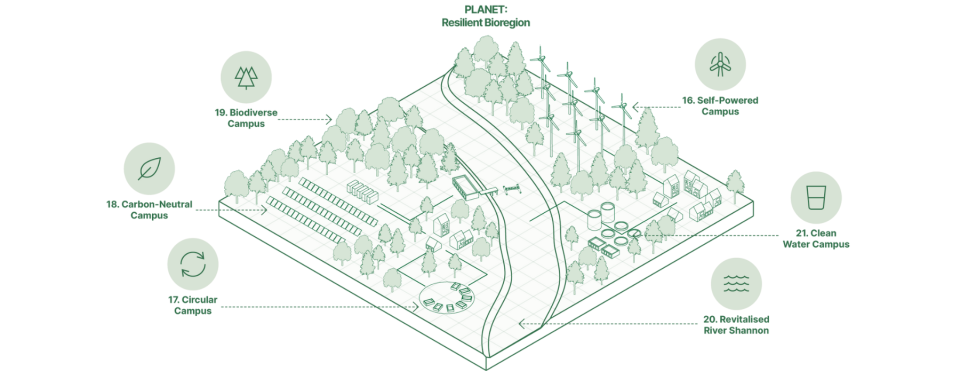
As a university renowned for its natural beauty, UL has the responsibility to ensure its physical presence does not negatively impact the health of the surrounding Shannon bioregion. We understand that our ecological systems act as the bedrock for the flourishing of all life on earth. Their safekeeping requires UL to take on the role of custodians; restoring the local natural environment to optimal health and protecting it from any future damage.
By 2030, UL will increase the biodiversity and volume of plant and animal life
on campus to maintain ecologically healthy levels.
A balance of plant and animal species, in combination with diverse microorganism populations, is how natural ecosystems maintain their health. This mission sees UL increase the levels of biodiversity on our campus grounds and surrounding areas to ecologically healthy levels. Doing so will protect and support the invaluable presence wildlife has on our university, and increase the areas ecological resilience.
Learn More
By 2030, UL will act as a test bed for the development and scaling of sustainable energy systems.
New forms of energy production and storage are essential to the transition toward a clean energy society. This mission sees UL act a test-bed for the development of sustainable energy systems. In doing so, the campus will become a hub for innovation partners to research and demonstrate an array of clean energy solutions.
Learn More
By 2030, UL will act as a test bed for the development of circular material flows and material usage.
New ways of making and consuming are essential to the transition toward a circular economy. This mission sees UL act a test-bed for the development of circular systems. In doing so, the campus will become a hub for innovation partners to research and demonstrate an array of circular production and consumption solutions.
Learn More
By 2030, UL will have achieved carbon neutral status.
The dramatic reduction of carbon emissions is essential to achieve our climate goals. This mission sees UL transform our campus into one which has no net release of carbon dioxide into the atmosphere. To do so, the campus carbon footprint will be eliminated through reduced emissions, carbon sequestration, and carbon offsetting.
Learn More
By 2030, UL will optimise campus water accessibility, and water management and protection.
The health and resilience of our water supply is foundational to the thriving of all life on our campus. This mission sees UL implement sustainable water infrastructure to increase water accessibility, management and protection. In doing so, the campus will become saturated with sources of fresh drinking water, all while guaranteeing a significant reduction in water waste and pollution.
Learn More
By 2030, UL will have significantly contributed to the ecological health of the Shannon River and its associated natural ecosystems.
UL has an intimate relationship with the River Shannon; it runs through the heart of our campus and opens its waters to our community. This mission sees UL become stewards of the revitalisation of River Shannon. In doing so, the river will flourish through water protection and habitat restoration, and sustainable social-use.